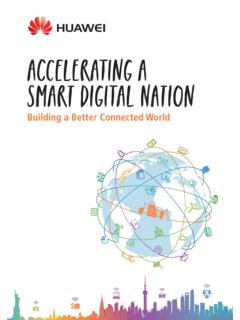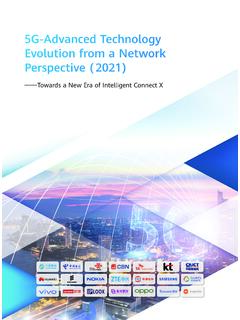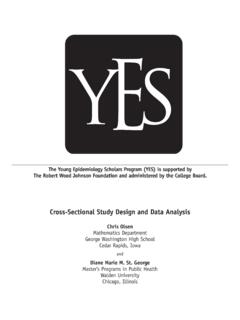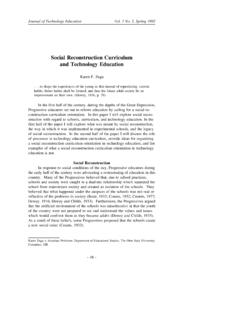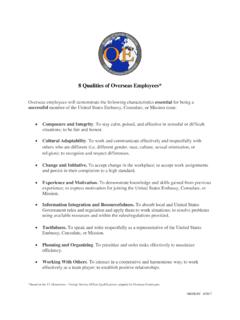Transcription of Virtual Reality/Augmented Reality White Paper - huawei
1 Virtual Reality /Augmented Reality White Paper (2017) China Academy of Information and Communications Technology (CAICT) huawei Technologies Co., Ltd December 2017 COPYRIGHT NOTICE This White Paper is copyright of CAICT and is protected by applicable laws. The reproduction of text or opinions contained in this White Paper , by forwarding, excerpts, or any other means, requires you to specify "source: CAICT". Violation of this notice will render you liable for legal proceedings. Acknowledgement Under the guidance of the department of electronics and information, Ministry of Industry and Information Technology, this White Paper was jointly prepared by China Academy of Information and Communications Technology (CAICT) and huawei Technologies Co.
2 , Ltd. During the preparation, CAICT gained professional support from the following parties: the iLab and the 2012 Labs of huawei Technologies Co., Ltd.; the Innovation Business Department and the Virtual Reality content creation center of BOE Technology Group Co., Ltd.; GoerTek; China Telecom Shanghai Research Institute; Whaley VR; air360china; and HiScene. Due to factors such as limited time, knowledge, and the still developing industry, there might be mistakes in this White Paper . Please feel free to correct us anytime. Preface Virtual Reality (VR)/Augmented Reality (AR) is a key field of the new-generation information and communications technology, which features large application space, huge industry potential, and wide technical span.
3 It has great significance to driving the transformation and upgrade of core components, extensive smart devices, network transmission devices, cloud computing devices, telecom services, and software and industry information services. VR/AR has a long technical history. However, it is an emerging industry and the development of the VR/AR industry and technologies has not been fully finalized. From the perspective of technology, near-eye display, rendering processing, perception and interaction, network transmission, and content creation are forming the primary system. From the perspective of industry structure, the VR industrial system depends on components/equipment, tools/platforms, and contents/applications.
4 When compared with the relatively mature intelligent terminals, VR has a similar industrial system. However, significant differences also exist. In this White Paper , the following aspects are systematically described: VR concepts, levels of VR experience, technology architecture, segment systems, and technology development roadmaps. In addition, a detailed segment map of China's VR industry was produced based on China's local VR enterprises and their roles in the key points of the VR industry chain. The White Paper also analyzes the industry ecosystem and development trends, based on which development suggestions are offered to telecom operators. CAICT Virtual Reality /Augmented Reality White Paper (2018) Contents 1 Background 2 Evolution of the VR Concept and Its Form Divisions 2 VR Rises Because of Lowered Threshold, Focused Capital, and Policy Support 4 VR Becomes the Development Focus in the Mobile Internet Evolution Towards the Artificial Intelligence Era 6 2 Key Technology Trend 7 Preliminary Formation of the VR Technology Architecture 7 Immersive Experience Improvement and Dizziness Control: Trends of Near-Eye Display Technologies 9 High Angular Resolution and Wide FOV: Key to Improve Immersive VR Experience 9 Dizziness Control: a Challenge to VR Near-Eye Display 10 AMOLED, LCOS, and OLEDoS.
5 Leading Near-Eye Screen Technologies 10 Tracking and Positioning, Environment Understanding, and Multi-Channel Interaction: Focuses of Perception and Interaction Technologies 12 Tracking and Positioning: a Core Technology in the Field of VR and AR Perception and Interaction 12 Environment Understanding Based on Machine Vision: Trend of AR Perception and Interaction 13 Multi-Channel Interaction: Trend of VR Perception and Interaction 13 High Bandwidth, Low Latency, Large Capacity, and Service Isolation: Trends of Network Transmission Technologies 15 New Wi-Fi, Large-Capacity PON, and 5G: Trends of Access Network Technologies for VR 15 Simple Architecture, Smart Pipe, Multicast On Demand, and Network Isolation Are Development Trends of Bearer Networks for VR Services 16 A Low-Latency Data Center Is Key to VR Computing Capability Cloudification 18 Projection, Coding, and Transmission Technologies Are Key to Optimizing the VR Network Performance 19 VR-oriented Network O&M and Evaluation Are Important for Improving User Experience 19 Combination of Enhanced Rendering Algorithms and Capabilities Are Trend of Rendering Processing Technologies 21 3 Industry Ecosystem Trend 24 Components/Devices, Tools/Platforms.
6 And Content Applications Dominate in the VR Industry Ecosystem 24 Perception and Interaction and Content Creation Become Development Focuses of VR in the Next Phase 25 IPR Competition Represents the Industry Development Trend 27 Global IPR Development Entered a Rapid Growth Stage, and the Growth Rate in China Is Notable 27 Emergence of the VR/AR+ Era 28 In VR+ Industries, VR is the key in smart manufacturing 29 In VR+ Medicine, VR is applied in surgery training/guidance, psychiatry, and rehabilitation. 30 In VR+ Games/ social Networking, VR gaming will become the biggest drive of the current VR industry. 30 In VR+ Movie/Live Broadcast, VR becomes a new form of display. 31 4 Recommendations on the Development of the VR Industry for Operators 31 2 Operators Are One of the Core Links of the VR Industry Chain, Providing Assurance for VR Service Experience and Enabling Service Popularization 32 Operators Drive the Evolution of VR Service Forms: From Virtual Cinemas to Live VR, and Then to Cloud-based VR Services 32 VR Service Development Recommendations for Operators 33 1 Background Evolution of the VR Concept and Its Form Divisions The industry's definition for VR evolved from terminals to immersive experience.
7 With the continuous development of technologies and the industry ecosystem, the VR concept will keep evolving. Therefore, the industry's discussion on VR is no longer limited to the form factor of terminals or how VR is realized. Instead, the focus now is experience, emphasizing key technologies, industry ecosystem, and integrated innovations in the application aspects. In this White Paper , it is understood that VR/AR uses next-generation information and communications technologies in near-eye display, perception and interaction, rendering processing, network transmission, and content creation to build a new industry across terminals, channels, and the cloud, satisfy customers' requirements for an immersive experience, and drive the expansion and upgrade of information consumption and the integrated innovation in traditional industries.
8 The improvement of an immersive experience depends on breakthroughs and progress of relevant technologies, which is a staged evolution process. Therefore, the VR service development is divided into the following stages, with different development stages corresponding to different experience requirements. Figure 1-1 Levels of VR immersive experience Source: CAICT CAICT Virtual Reality /Augmented Reality White Paper (2018) Figure 1-2 VR immersive experience network requirements Source: huawei iLab VR terminals evolve from one to many form factors, and from separated to integrated. In terms of terminal form factors, the mobile phone type has become the major terminal type at this stage. Globally, phone-based VR accounted for nearly 90% in 2016.
9 By 2020, it is estimated that the penetration rate of PC-based and all-in-one VR terminals will rise to about 50% (Figure 1-3). As ICT giants such as Google, Facebook, and Apple held their 2017 global developer conferences (I/O, F8, and WWDC respectively), phone-based AR has become the mainstream for the mass market. Meanwhile, PC-based and all-in-one AR terminals such as Meta2 and Hololens dominate the enterprise market. In addition, under the influence of the self-driving cars and Internet of Vehicles (IoV) trends, built-in display-at-a-glance AR has become the emerging field. Ultimately, the forward-looking contact lenses form factor represents the industry's final expectation for AR design. In terms of terminal functions, VR generally includes AR.
10 In the early stages, AR was usually discussed under the VR framework. However, with the continuous effort put into AR by the industry, AR and VR are gradually being separated. Specifically, VR and AR are mutually independent, with similarities in key components and terminal form factor, but differences in key technologies and application fields. Unless stated otherwise, this White Paper discusses VR and AR in a general sense. VR uses isolated audio and video contents for an immersive experience, which poses high requirements on image quality. AR integrates Virtual information to the real environment seamlessly, which poses high requirements on perception and interaction. In addition, VR focuses more on mass markets such as games, videos, live broadcast, and social media , whereas AR focuses more on vertical applications such as in different industries and for the military.

